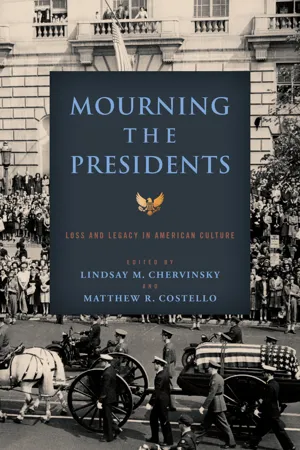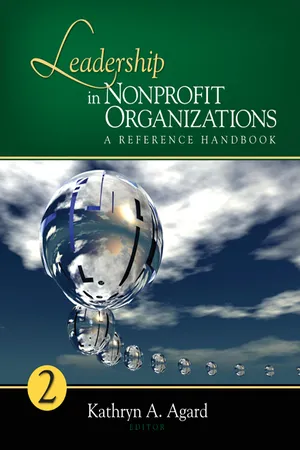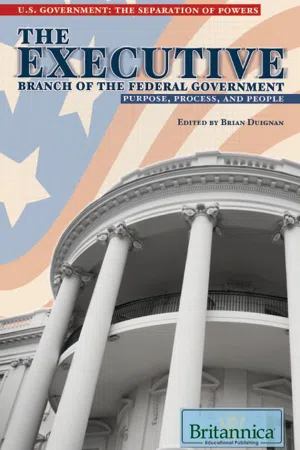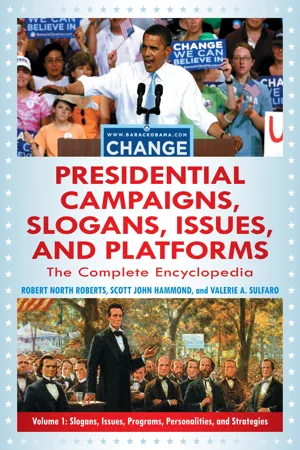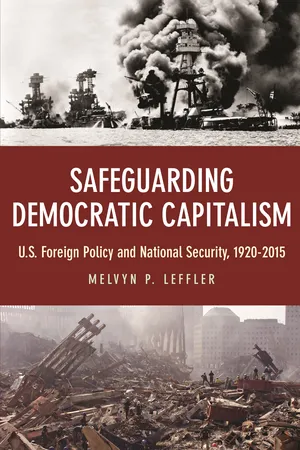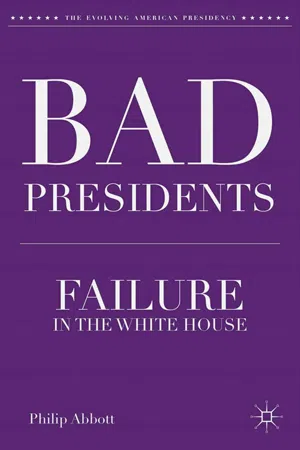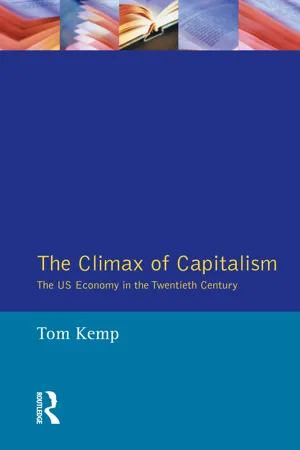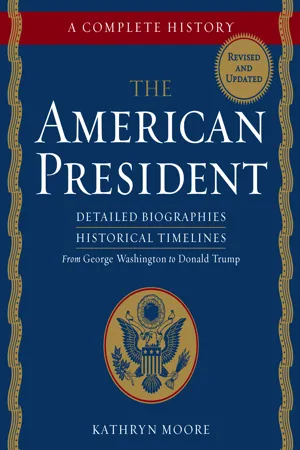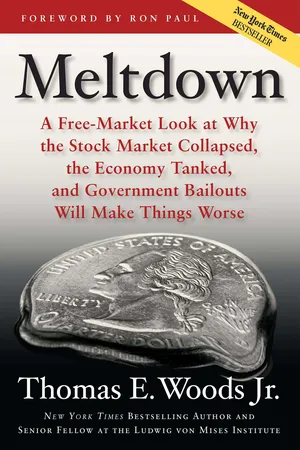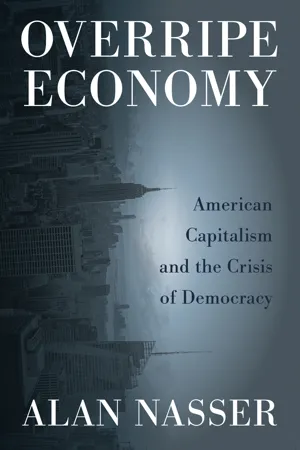History
President Hoover
President Hoover was the 31st President of the United States, serving from 1929 to 1933. He is often associated with the Great Depression, as his presidency coincided with the start of this economic crisis. Hoover's response to the Depression was criticized, and he was unable to effectively address the widespread unemployment and financial hardship during his time in office.
Written by Perlego with AI-assistance
Related key terms
Related key terms
1 of 4
Related key terms
1 of 3
12 Key excerpts on "President Hoover"
- eBook - ePub
Miller Center Studies on the Presidency
Loss and Legacy in American Culture
- Lindsay M. Chervinsky, Matthew R. Costello, Lindsay M. Chervinsky, Matthew R. Costello(Authors)
- 2023(Publication Date)
- University of Virginia Press(Publisher)
Before entering the White House, he had been a Progressive of sorts: a backer of Theodore Roosevelt’s Bull Moose campaign in 1912 and an advocate of solving problems via scientific reasoning and impartial administration. Expectations for his presidency soared, but Hoover’s responses to the Great Depression—reliance on private charity to help poor people, confidence-boosting sessions with industrial leaders, loans to banks, and acceleration of public works projects—failed to curb unemployment and allay discontent. Americans blamed him for hard times by labeling impoverished areas “Hoovervilles” and bemoaning “Hoover’s depression.” 10 The administration’s heavy-handed expulsion of indigent veterans in the Bonus Army from Washington, DC, in 1932 sealed Hoover’s fate: He lost to FDR in a landslide. Following the defeat, Hoover stayed politically engaged, albeit with few positive results. He angled without success for the Republican nominations in 1936 and 1940, and he assailed the New Deal as “collectivism” and at odds with “the American system of liberty.” 11 Such verbal salvos positioned Hoover closer to conservatives, who earlier had distrusted him, while making him a “forgotten Progressive and remembered reactionary” to the general public. 12 Hoover’s opposition to US involvement in World War II earned praise from isolationists, but the attack on Pearl Harbor in 1941 left him sidelined: Roosevelt declined to give his former foe a wartime assignment and “raise him from the dead.” 13 Many Republicans, including presidential nominee Thomas E. Dewey, wanted no association with the former president or the Depression, which remained Hoover’s albatross. 14 In his Memoirs (1952), Hoover blamed the downturn on events overseas and on FDR’s New Deal, which he claimed had delayed recovery. 15 Yet a stale writing style hindered his argument - eBook - ePub
Leadership in Nonprofit Organizations
A Reference Handbook
- Kathryn A. Agard(Author)
- 2010(Publication Date)
- SAGE Publications, Inc(Publisher)
14Hoover’s view was immensely attractive to many Americans in his day, and it remains so today. George H. W. Bush successfully mobilized volunteerism with his articulation of the “thousand points of light.” But of course, the Great Depression presented a uniquely devastating set of challenges. Local governments and charities collapsed under the tremendous weight of citizens’ needs, and beleaguered Americans had fewer resources to give. The sad irony of Hoover’s presidency is that his heroics during and after World War I had been successful, yet had forged in him a philosophy ill-equipped to deal with the depths of the Great Depression. Civil society could not be counted on to provide relief when civil society itself was crumbling.After losing the 1932 presidential election, Hoover went on to provide a tremendous model for what an ex-president can do to promote philanthropy. First, he lent his prestige to charitable organizations after leaving the White House. The Boy Scouts of America, Boys’ Clubs of America, and the American Red Cross, in particular, benefited from Hoover’s support. His name was printed on their letterhead; he wrote personal letters of support; and he became their champion.Second, he was at his president’s call to serve. After World War II, he was dispatched by President Truman to assess food needs and food surpluses and to draft commission reports that would shape presidential policy. In the spring and summer of 1946, Hoover—age 71—personally visited nearly 40 nations. He was indefatigable. In March, he visited Canada, Portugal, France, Italy, Switzerland, Czechoslovakia, Poland, and Finland. In April, he was in Sweden, Norway, England, Belgium, Holland, Denmark, Germany, Austria, Yugoslavia, Greece, Egypt, Iraq, India, Thailand, and the Philippines. In May, he was in China, Korea, Japan, Mexico, Panama, Colombia, and Ecuador. Finally, in June, Hoover visited Peru, Chile, Argentina, Uruguay, Brazil, Venezuela, and Cuba. Along the way, Hoover gauged the world’s needs, met with world leaders to enlist their support, delivered impassioned speeches, and remained connected to the American people and president. Hoover’s travel journal, where he wrote that he had to attend all events “with a mighty painful back,” may be the single most valuable firsthand account of geopolitics in the wake of World War II.15 - Katherine A.S. Sibley, Katherine A.S. Sibley(Authors)
- 2014(Publication Date)
- Wiley-Blackwell(Publisher)
Herbert Hoover and the Reconstruction Finance Corporation, 1931–1933 . Ames: Iowa State University Press.- Robinson, Edgar Eugene, and Vaughn Davis Bornet. 1975. Herbert Hoover: President of the United States . Stanford, CA: Hoover Institution Press.
- Romasco, Albert U. 1968. The Poverty of Abundance: Hoover, the Nation, the Depression . New York: Oxford University Press.
- Rothbard, Murray N. 1963. America’s Great Depression . Los Angeles: Nash Publishing.
- Schlesinger, Arthur M., Jr. 1957. The Age of Roosevelt: The Crisis of the Old Order, 1919–1933 . Boston: Houghton Mifflin.
- Schwarz, Jordan A. 1970. The Interregnum of Despair: Hoover, Congress, and the Depression . Urbana: University of Illinois Press.
- Shlaes, Amity. 2008. The Forgotten Man: A New History of the Great Depression . New York: HarperCollins.
- Smith, Gene. 1970. The Shattered Dream: Herbert Hoover and the Great Depression . New York: William Morrow.
- Smith, Richard Norton. 1984. An Uncommon Man: The Triumph of Herbert Hoover . New York: Simon & Schuster.
- Sobel, Robert. 1975. Herbert Hoover and the Onset of the Great Depression, 1929–1930 . Philadelphia: J.B. Lippincott.
- Stimson, Henry L., and McGeorge Bundy. 1948. On Active Service in Peace and War . New York: Harper & Brothers.
- Tice, Bradley S. 2004. Herbert Hoover’s Intellectual Development . Bloomington: Indiana University Press.
- Walch, Timothy, ed. 2003. Uncommon Americans: The Lives and Legacies of Herbert and Lou Henry Hoover . Westport, CT: Praeger.
- Walch, Timothy, and Dwight M. Miller, eds. 1998. Herbert Hoover and Franklin D. Roosevelt: A Documentary History . Westport, CT: Greenwood Press.
- Warren, Harris Gaylord. 1959. Herbert Hoover and the Great Depression . New York: W.W. Norton.
- Wilbur, Ray Lyman. 1960. The Memoirs of Ray Lyman Wilbur , ed. Edgar Eugene Robinson and Paul Carroll Edwards. Stanford, CA: Stanford University Press.
- Wilbur, Ray Lyman, and Arthur Mastic Hyde. 1937. The Hoover Policies . New York: Charles Scribner’s Sons.
- Wilson, Carol Green. 1968. Herbert Hoover: A Challenge for Today
- eBook - ePub
The Executive Branch of the Federal Government
Purpose, Process, and People
- Britannica Educational Publishing, Brian Duignan(Authors)
- 2009(Publication Date)
- Britannica Educational Publishing(Publisher)
More problems arose in 1932, when Hoover authorized Gen. Douglas MacArthur to evict from Washington, D.C., the Bonus Army, a group of World War I veterans who had camped in the nation’s capital to pressure Congress into awarding a promised bonus many years in advance of the scheduled payout date. The result was a public relations nightmare for the president.By the 1932 presidential campaign, Hoover was blaming the Depression on events abroad and predicting that election of his Democratic challenger, Franklin Delano Roosevelt, would only intensify the disaster. The electorate obviously thought differently, as Roosevelt captured nearly 23 million votes (and 472 electoral votes) to Hoover’s slightly less than 16 million (59 electoral votes). When he left the White House on March 4, 1933, Hoover was a defeated and embittered man.Hoover and his wife—the former Lou Henry, also a Stanford-trained geologist—moved first to Palo Alto, Calif., and then to New York City, where they took up residence at the Waldorf Astoria Hotel. For the next 30 years, Hoover was closely identified with the most conservative elements in the Republican Party, condemning what he regarded as the radicalism of the New Deal and opposing Roosevelt’s attempts to take a more active role against German and Japanese aggression. His last major activity was heading the Hoover Commission, under presidents Harry Truman and Dwight D. Eisenhower, which aimed at streamlining the federal bureaucracy. The research-oriented Hoover Institution on War, Revolution, and Peace at Stanford University—founded in 1919 as the Hoover War Collection, a library on World War I—is named in his honour.FRANKLIN D. ROOSEVELT
(b. Jan. 30, 1882, Hyde Park, N.Y.—d. April 12, 1945, Warm Springs, Ga.) F - eBook - ePub
Presidential Campaigns, Slogans, Issues, and Platforms
The Complete Encyclopedia [3 volumes]
- Robert North Roberts, Scott John Hammond, Valerie A. Sulfaro(Authors)
- 2012(Publication Date)
- Greenwood(Publisher)
Franklin Delano Roosevelt, cousin of Theodore Roosevelt, had been one of the Democrats’ rising stars since his campaign for the vice presidency 12 years earlier. A crippling battle against polio interrupted his ambitions; but blessed with a measure of resolve beyond the reach of most human beings, Roosevelt willed himself back into the political arena, even though the paralysis that resulted from the disease left him without the use of his legs. By 1924, three years after contracting the disease, Roosevelt was fully back in the political game and, having become one of the party’s more influential forces, appeared on crutches at the national convention that year to personally nominate his friend Al Smith, delivering a speech that energized the convention and helped to seal Smith’s reputation as the “Happy Warrior.” Roosevelt furthered his comeback in 1928, successfully campaigning for the governorship of New York and winning election in a landslide. Given that Republican gains were extensive in 1928, Roosevelt’s successful campaign as a Democrat was seen as all the more remarkable; as the decade was drawing toward a close, it was clear that FDR had indeed recovered the political momentum that he had lost due to the terrible affliction that he suffered near the decade’s opening.As Roosevelt ascended, President Herbert Hoover, confronted with the demoralizing effects of the Great Depression, dug in. Hoover, who had been elected in a landslide four years earlier, was an intelligent, honest, and capable leader; but the crisis was so extensive that his efforts, rooted in his commitment to the principles of “rugged individualism” and limited government, seemed too little and ultimately too late. Hoover firmly believed that the dynamics of private markets would inevitably pull the country up and out of the Depression, holding fast to the belief that the federal government needed to be cautious in the extent of its activity. It is not fair to Hoover’s reputation to depict him as indifferent to the sufferings of Americans during the Great Depression, or as merely the tool of monied interests looking out only for themselves. Hoover did have close ties to business, but he also had a long record of humanitarian service reaching back to his efforts to help Europeans recover from the aftermath of the Great War. But by the time of the election, the shantytowns of the homeless and unemployed that pockmarked the American urban landscape were known as “Hoovervilles,” and the candidate that once rode to a stunning political victory on the wave of prosperity was now buffeted hard by circumstances that he considered beyond his legitimate control. By 1932, the mood at the White House was somber and withdrawn, further adding to the perception that Hoover had become a distant, indifferent figure. - eBook - ePub
The Politics Presidents Make
Leadership from John Adams to Bill Clinton, Revised Edition
- Stephen Skowronek(Author)
- 1997(Publication Date)
- Belknap Press(Publisher)
Even as the economic crisis engulfed his presidency, Hoover remained active and methodically tested a range of different responses. Far from ignoring the severity of the situation, he employed the metaphors of wartime to combat it and became the first American president to meet a downturn in the business cycle with massive governmental interventions. Far from being shocked into paralysis, he secured virtually all his major proposals, including some critical departures from past practice. Far from standing fast against innovation, his administration anticipated much of what would occur during the early years of the New Deal. 4 Finally, we know that while Hoover’s policies did not bring recovery, neither did those of his more celebrated successor. Again, why would one great innovator fail so miserably and the next succeed so brilliantly? To the extent that Hoover revisionism adds credence to the “great misfortune” thesis, it makes an especially powerful case for political time in the explanation of presidential possibilities. Notwithstanding Theodore Roosevelt’s longings and Franklin Roosevelt’s example, Hoover’s experience highlights a dismal half-truth in the commonplace that great national crises spawn great political leaders. Not only does it remind us that a crisis tends to cut two ways—crushing one incumbent while elevating the next—it strongly suggests that the outcome turns rather bluntly on the incumbent’s political identity vis-à-vis the established regime. Despite his considerable efforts and manifest achievements, Hoover had little more success in political leadership than James Buchanan, for, like Buchanan, he was inextricably tied to the governmental commitments that events were calling into question. With political warrants wholly inadequate to controlling the meaning of his actions in the moment at hand, Hoover became the foil for a resurgent opposition bent on a general repudiation of the established regime - eBook - ePub
Safeguarding Democratic Capitalism
U.S. Foreign Policy and National Security, 1920-2015
- Melvyn P. Leffler(Author)
- 2017(Publication Date)
- Princeton University Press(Publisher)
2 Herbert Hoover, the “New Era,” and American Foreign Policy, 1921–1929 As a graduate student I read extensively in the burgeoning literature on the Progressive movement. New books and articles highlighted the diverse strands of progressivism and the complex motives of the so-called reformers. While Richard Hofstadter and George Mowry focused on the status revolution and the psychological adjustments necessitated by the economic transformation of the nation, Gabriel Kolko, Robert Wiebe, Alfred Chandler, and Samuel Hays illuminated the complexity of the business response and the importance of the managerial revolution under way. No student of the Progressive Era, however, could ignore the growing labor strife, the organization of working men and women, the challenge of assimilating millions of immigrants, and the spread of ideological radicalism. Robert Wiebe seemed most effectively to synthesize the divergent developments in his book The Search for Order, 1877–1920 (New York: Hill and Wang, 1967). In the quest for stability, professionals, managers, and enlightened businessmen loomed large. They appeared to possess the knowledge and the methods to study societal problems objectively, and to offer solutions that might reconcile clashing interests and serve the needs of the larger community without overextending the role of government. Herbert C. Hoover was such a man. In the 1970s, his place in American history was being reconceived by historians like Joan Hoff Wilson and Ellis Hawley. In their view, Hoover was not the heartless and dogmatic conservative who waged relentless war against the New Deal; actually, he was a “forgotten progressive.” (See Joan Hoff Wilson, Herbert Hoover: Forgotten Progressive [Boston: Little, Brown, and Company, 1975.]) Trained as an engineer, widely traveled, and committed to scientific management, Hoover wanted to use knowledge to transcend class divisions and national rivalries without overextending the reach of government - eBook - ePub
Bad Presidents
Failure in the White House
- P. Abbott(Author)
- 2013(Publication Date)
- Palgrave Macmillan(Publisher)
For instance, Martin Fausold has concluded that secretary of commerce Hoover was “the more liberal and progressive candidate in 1928.” 4 He received the support of Jane Addams, the Chicago reformer who had voted for Debs in 1920 and Robert H. La Follette in 1924. She endorsed Hoover’s farm policy and his positions on collective bargaining. (Hoover had gone on record as favoring the curtailment of “excessive use” of injunctions in labor disputes.) Addams also admired his concern for the poor. Similarly, Joan Hoff Wilson concluded in her biography that “the great engineer and humanitarian still lived beneath the new mantle of the Great Depression president,” and that Hoover was a “forgotten progressive and a remembered conservative.” 5 Some believe they have even detected in Hoover attempts to craft a political philosophy that was neither liberal nor conservative. William Appleman Williams describes Hoover as “the keystone in the arch that leads from Mark Hanna and Herbert Croly to such later figures as Nelson Rockefeller and Adolph Berle.” For Williams, Hoover was one of the first American leaders to see that the competitive capitalism characterizing much of American history was operationally obsolete and needed to be replaced by a cooperative system of both labor and capital led by a “class conscious industrial gentry.” 6 Ellis Hawley, a historian of both the 1920s and the New Deal, has taken Williams’s observation one-step further - eBook - ePub
The Climax of Capitalism
The U.S. Economy in the Twentieth Century
- Tom Kemp(Author)
- 2014(Publication Date)
- Routledge(Publisher)
One result of the general fall in prices and a lower cost of living was that consumption fell less than income and output. Indeed, some people might have been better off than before; but they were a minority. The general fall in income meant a disproportionate fall in the demand for house space (as housing figures show) and for durables.Hoover's Response
The Republican administration headed by Herbert Hoover was very much a product of the optimistic 1920s; it now had to handle a situation as intractable as it was unforeseen. Hoover was a man of moderation; a friend of business and a believer in market forces, he did not want to see either organized business or the state become too powerful. A competent administrator, his deep belief in the virtues of capitalism conditioned his initial response to the depression. Thus the budget had to be balanced and financial orthodoxy maintained; not the state, but rather business itself, could fight the depression. The administration had to assist it by building confidence, not by intervention in the market. The essence of his policy was belief in the self-righting mechanism of free market forces.Hoover could not be accused of inactivity in the early stages; he saw his role as boosting business morale and preventing anything which might aggravate the decline. He called on business to maintain employment and avoid wage-cutting, but he did not resist the growing protectionist reaction, especially among farmers, approving the Hawley-Smoot tariff in June 1930, against his better judgement, in the face of impending Congressional elections. The result was the opposite of that sought; retaliatory tariffs by other countries hastened the decline of American exports, aggravating the depression.As time went on, Hoover had to authorize rescue operations which required a certain amount of state intervention and expenditure, but he doggedly resisted proposals for large-scale public works or relief for the unemployed. Veterans of the First World War who gathered in Washington to demand bonus payments in advance of the due date met with a stony reception and were finally dispersed by the military. - eBook - ePub
The American President
A Complete History
- Kathryn Moore, Kathryn Moore(Authors)
- 2018(Publication Date)
- Union Square & Co.(Publisher)
H ERBERT H OOVER ★ ★ ★ THIRTY-FIRST PRESIDENT ★ ★ ★LIFE SPAN • Born: August 10, 1874, in West Branch, Iowa • Died: October 20, 1964, in New York City NICKNAME • Bert, The Chief RELIGION • Quaker (Society of Friends) HIGHER EDUCATION • Stanford University, 1895 PROFESSION • Engineer MILITARY SERVICE • None FAMILY• Father: Jesse Clark Hoover (1846–1880)• Mother: Huldah Randall Minthorn Hoover (1848–1883)• Wife: Lou Henry Hoover (1874–1944); wed on February 10, 1899, in Monterey, California• Children: Herbert Charles (1903–1969); Allan Henry (1907–1993)POLITICAL LIFE• Relief efforts during World War I: Belgium Relief (1914–1919); US Food administrator (1917–1918); War Trade Council (1917–1920); Sugar Equalization Board (1918–1920); European Coal Council (1919); American Relief Administration (1919–1920); economic director of Supreme Economic Council (1918–1920); economic advisor to President Woodrow Wilson at Versailles Peace Conference• Secretary of commerce (1921–1928) PRESIDENCY • One term: March 4, 1929–March 4, 1933 • Republican• Reason for leaving office: defeated by Franklin D. Roosevelt in 1932 election• Vice president: Charles Curtis (1929–1933)ELECTION OF 1928• Electoral vote: Hoover 444; Alfred E. Smith 87• Popular vote: Hoover 21,427,123; Smith 15,015,464Ironically, the president whose name became synonymous with the stock market crash of 1929 and the Great Depression is the same one who worked tirelessly both before and after his presidency around the world to improve conditions for those less fortunate. His life was an American dream come true—the boy of modest means who works his way through school and then, with a driving determination to succeed, becomes a self-made millionaire.CABINET ★ ★ ★ ★ ★ ★ ★ ★ ★ ★SECRETARY OF STATE Henry L. Stimson (1929–1933) SECRETARY OF THE TREASURY Andrew W. Mellon (1929–1932) Ogden L. Mills (1932–1933) SECRETARY OF WAR James W. Good (Mar.–Nov. 1929) Patrick J. Hurley (1929–1933) - eBook - ePub
Meltdown
The Classic Free-Market Analysis of the 2008 Financial Crisis
- Thomas E. Woods(Author)
- 2009(Publication Date)
- Regnery(Publisher)
For decades, American schoolchildren were—and many still are—taught that President Herbert Hoover, who is described as a strict proponent of laissez faire, sat back and did nothing as the Great Depression devastated the country. Only when Franklin Roosevelt took office in March 1933 was serious action taken to arrest the economy’s decline. Although most schoolteachers perpetuate this myth even now, it would be considered embarrassing in historical circles to repeat this version of events today.Hoover expressly said that the laissez-faire approach to the economy was a thing of the past. No peacetime president in American history intervened in the economy to the extent Hoover did. Among other things, he launched public works projects, raised taxes, extended emergency loans to failing firms, hobbled international trade, and lent money to the states for relief programs. He sought to prop up wages at a time when consumer prices were falling dramatically, thereby calling on firms in effect to give raises to their workers at a time of great business vulnerability. This is why Franklin Roosevelt accused Hoover, during the 1932 presidential campaign, of having presided over “the greatest spending administration in peacetime in all of history,” and derided him for believing “that we ought to center control of everything in Washington as rapidly as possible.” FDR’s running mate, John Nance Garner, declared that Hoover was “leading the country down the path to socialism.”33 Meanwhile, the Depression just grew worse and worse.In 1932, two dozen of the country’s leading economists gathered at a conference at the University of Chicago to make recommendations to the federal government. From the point of view of Austrian business cycle theory, the advice they offered to President Hoover was almost uniformly bad, including a more inflationary monetary policy, more subsidies for banks via the Reconstruction Finance Corporation, and a robust program of public works spending—highways, dams, and more.Two of the participants did offer sound advice, and were of course ignored. One was Gottfried von Haberler, a proponent of Austrian business cycle theory who denounced the “quacks . . . preaching inflationary measures.” The other voice of sense was H. Parker Willis, a Columbia University professor of economics and former editor of the Journal of Commerce who warned that further inflation of the money supply would only intensify existing resource misallocation. “Any such step at the present time,” he explained, “would simply mean an aggravation of existing difficulties, due to the fact that we are already overburdened with construction work and fixed capital that are not likely soon to be employed.” 34 - eBook - ePub
Overripe Economy
American Capitalism and the Crisis of Democracy
- Alan Nasser(Author)
- 2018(Publication Date)
- Pluto Press(Publisher)
Hoover finally caved in under the banks’ pressure and in 1931 increased taxes to shrink or eliminate the deficit. The effect was predictable: deflation intensified and counteracted whatever price-stabilization effects voluntary cartelization might have had. The administration seemed confused and rudderless, and Hoover’s image was dealt another blow by newsreel and newspaper coverage of his cruel and violent treatment in 1932 of the veterans participating in the Bonus Army March (see page 91) on Washington. Hoover’s analysis remained within the bounds of modified orthodoxy described above. He consistently refused to provide unemployment relief at the federal level. Hoover was unwilling to use State power in the service of workers in trouble, to apply the notion of “political capitalism” to the unemployment crisis the way State support of regulatory agencies had employed political capitalism on behalf of threats to business interests. The popular response to Hoover’s inactivity was reflected less than one month later in the massive defeat suffered by Republicans in congressional elections. They lost fifty-two seats in the House and eight in the Senate.The now-unpopular Hoover was defeated in the 1932 election and Franklin Roosevelt was brought to office, setting the stage for the first grand experiment in massive government social spending in American history, the New Deal. The political economy of the New Deal was shaped by two key factors: the interweaving of the structural constraints and imperatives of secular stagnation, and the class struggle between a working class whose hopes of endless prosperity had been dashed by a Depression that government appeared unwilling or unable to address and a capitalist class anxious about government action changing the balance of power which, until then, had retained a pronounced tilt in its favor. We begin with the working-class end of this struggle as it began during the Hoover administration.POPULAR DISSENT OVERCOMES THEPOLITICAL APATHY OF THE 1920S
The Depression wakened the U.S. working population from the political slumber into which the 1920s, with its ethos of consumerism, had cast it. This ethos had been built by the linking of consumption to the core American value of freedom, which had long been thought of as central to what it means to be an American. Solidarity had never been as highly placed among American values as “freedom” had been. The preeminent symbol of freedom in the 1920s was, unsurprisingly, also the preeminent consumable, the automobile. In this culture built on working-class defeat and the equation of liberty and consumption, equality and solidarity had no place. Nor did political resistance.
Index pages curate the most relevant extracts from our library of academic textbooks. They’ve been created using an in-house natural language model (NLM), each adding context and meaning to key research topics.
Explore more topic indexes
Explore more topic indexes
1 of 6
Explore more topic indexes
1 of 4
